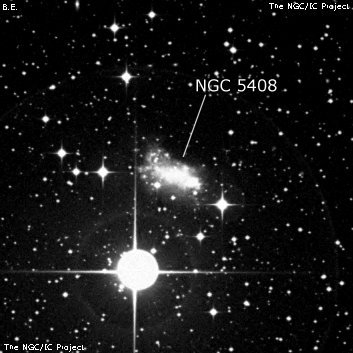NGC/IC Project Restoration Effort
(This is a very very beta version)
NGC5408


Basic Information
Location and Magnitude
Right Ascension: 14:3:21.0
Declination: -41:22:43
Constellation: CEN
Visual Magnitude: 11.6
Historic Information
Discoverer: Herschel J.
Year of discovery: 1834
Discovery aperture: 18.3
Observational
Summary description: eF, E, bet 2 vS st
Sub-type: IBm
Corwin's Notes
=====
NGC 5408 is a late type irregular galaxy seen through considerable Galactic
obscuration; there are several superposed stars. Toward the southwestern end
of the galaxy is an HII region (perhaps catalogued as Henize 3-0959 at
14 03.3, -41 22 [J2000], an emission-line star in 1976ApJS...30..491H), that
has been mistakenly called a planetary nebula in some papers. In others (and
in SIMBAD as of August 2015), the Henize number has been applied to NGC 5408
itself -- this, too, is incorrect.
The structure of the galaxy is not clear on the DSS images, but appears to be
similar to a slightly "later" version of the LMC. For SGC, I called it an
IB(s)m, but did not assign a luminosity class. In any case, the center of the
galaxy is uncertain. The position I've listed here is based on the DSS2R
image. Surface photometry is clearly needed.
Steve's Notes
=====
NGC 5408
22" (6/28/06 - Hawaii): at 200x; NGC 5408 appeared fairly faint, small, elongated ~2:1 SW-NE, 0.8'x0.4'. A faint star is at the southwest end. Located just 3' NNW of mag 6.1 HD 122532 and the galaxy is bracketed by a mag 10 star 1.5' SW and a mag 11 star 2' E. The "faint star" noted on the southwest end may be an ultra-luminous star formation region (see below).
This nearby dwarf irregular starburst galaxy lies 15.6 million light years distant in the M83/Centaurus A group. It was misclassified as a planetary nebula in the first edition of the Sky Catalogue 2000 and NGC 2000. Henize 3-959 = StWr 4-9 likely refers to the small clump of HII regions on the southwest side of the galaxy.



